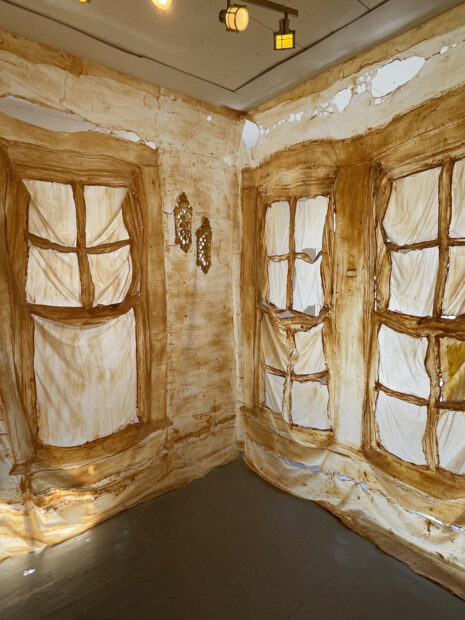
Carlie Trosclair, “Floodplain|uᴉɐldpoolℲ,” on view at Project Row Houses as part of “Round 54: Southern Survey Biennial.”
In her intimate, haunting contribution to Project Row House’s Round 54: Southern Survey Biennial, New Orleans artist Carlie Trosclair reimagines a home’s genealogy. Her multiple installations, collectively entitled Floodplain|uᴉɐldpoolℲ, consist of ethereal yet insistently material latex casts that evoke the aftermath of a natural disaster all too familiar to southern viewers: a flood.
Trosclair’s work occupies 2517 Holman Street, one of the white, single story houses converted to exhibition spaces by Project Row Houses in Houston’s historic Third Ward. Depending on where a visitor begins, Trosclair’s Floodplain|uᴉɐldpoolℲ serves as either introduction or punctuation mark to the Southern Survey Biennial.
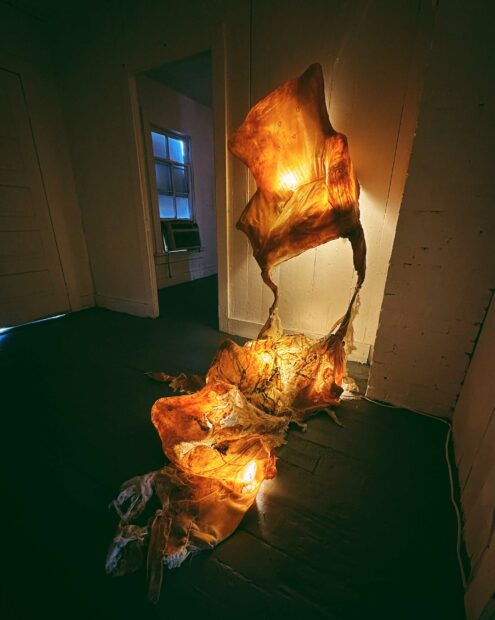
Carlie Trosclair, “Floodplain|uᴉɐldpoolℲ,” on view at Project Row Houses as part of “Round 54: Southern Survey Biennial.”
In each space, southern artists explore themes of community, loss, and remaking. Kandy G. Lopez (Texas) fills a home with larger-than-life-sized portraits — crafted from yarn — of bold, confident people of color. Julien Hyvrard (Florida) recreates a transitional housing facility, inviting visitors to sit or lay in the space as they listen to the stories of those reintegrating into society. Victoria Ravelo (Florida) and Naomi Lemus (Texas) transform used clothing and accessories borrowed from working class communities of color in Houston into an intimate web. Likewise, Sedrick Huckaby (Texas) and Rehab El Sadek (Texas) each use discarded objects as materials for new, imaginative constructions. And Rashayla Marie Brown (Texas) pays tribute to those seeking justice for their ancestors.
At the end of the row, Trosclair’s installations conjure a space for holding — or perhaps releasing — all these bodies, stories, and objects. When we enter the front room of the row house, we are paradoxically invited to enter into it once again. Within|between is a suspended room-within-a-room, constructed from paper-thin, ochre-hued latex casts of the home’s own walls. As the title suggests, we can enter into the hanging room and stand within the skin-like walls, or we can walk in the gap between the cast and its original.
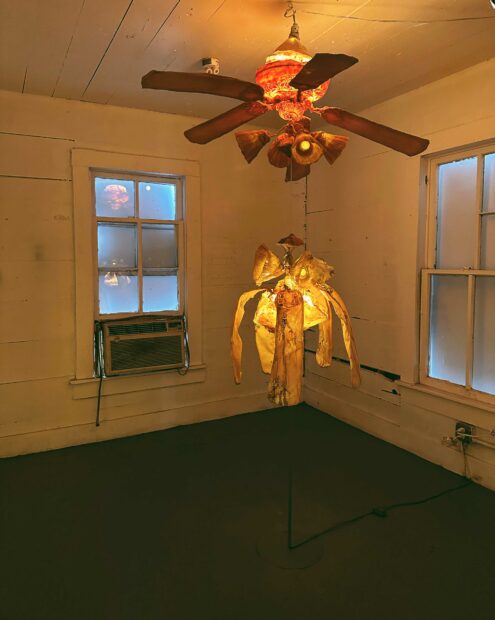
Carlie Trosclair, “Floodplain|uᴉɐldpoolℲ,” on view at Project Row Houses as part of “Round 54: Southern Survey Biennial.”
The doubled space is contingent and even porous. Empty picture frames, the lattice work of decorative sconces, and tears in fragile window panes perforate the ghostly walls, offering glimpses of the solid, permanent structure beyond. At the same time, wooden splinters and flakes of paint cling to the latex skin. The seemingly secure space of the home becomes permeable and vulnerable.
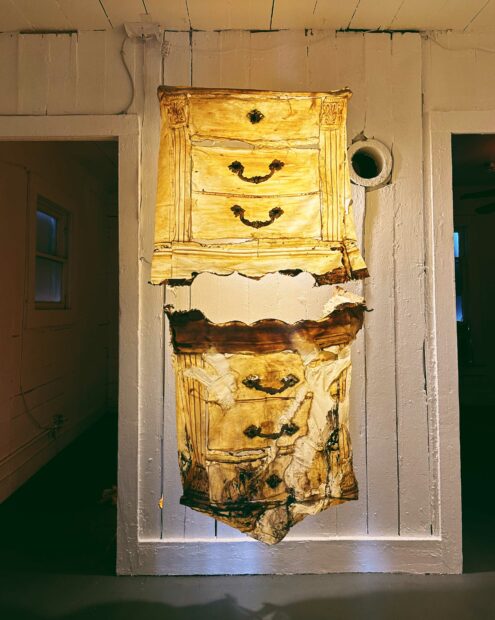
Carlie Trosclair, “Floodplain|uᴉɐldpoolℲ,” on view at Project Row Houses as part of “Round 54: Southern Survey Biennial.”
This sentiment takes on a particular urgency in the context of Houston’s Third Ward, the historically African American neighborhood where Project Row Houses is located. By the late nineteenth century, the Third Ward was a dynamic center of Black businesses, churches, and schools, and it nurtured civil rights activism in the 1960s. However, burgeoning gentrification has left many residents wondering if they will be forced to leave their lifelong homes. Further, the confluence of climate change, aging infrastructure, and inequitable funding has left the Third Ward particularly at risk to catastrophic damage from natural disasters like Hurricane Harvey in 2017 and the deep winter freeze in 2021. Trosclair’s within|between evokes the hovering anxiety of past or potential displacement and the loss of one’s beloved space.
The other small rooms of the row house are dotted with a collection of sculptural casts: Floodplain|uᴉɐldpoolℲ. Cast in latex and lit from within, a nightstand, fireplace mantle, chair, and ceiling fan seem to float at an invisible waterline. Each object is doubled, with the copy hanging upside-down like a watery reflection. The pooling, tattered doppelgangers are caked in mud from the Mississippi River.
Here, Trosclair draws from her own experiences of Hurricane Katrina’s devastation in New Orleans to explore the relationship of presence, absence, and memory. In each installation, the object itself is absent. There is the shell of the nightstand, but no actual piece of furniture. But the memory of the object as it was, and the memory of the object after the flood are literally and inextricably tethered. Often, the flooded remnants transform into something else entirely. The inverted chair suggests an ominous carcass, while the drooping reflection of the ceiling fan evokes a faded, collapsed flower.
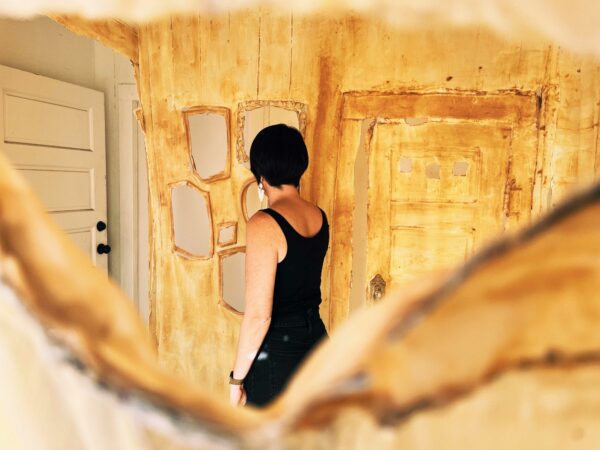
Carlie Trosclair, “Floodplain|uᴉɐldpoolℲ,” on view at Project Row Houses as part of “Round 54: Southern Survey Biennial.”
But Trosclair is not simply referencing literal floods. After all, the Third Ward has a lower risk of flooding than other areas in Houston. But ironically, the slight elevation that protects it from floods also makes it more attractive to developers looking to erect new, larger, and higher-priced homes that reshape the built environment and displace longtime residents and their social memory.
It is this evacuation of the past that Trosclair wants us to pay attention to. Following the late poet and author Toni Morrison, she locates a haunting resonance between flooding and memory. In her essay “The Site of Memory,” Morrison describes floods as water’s remembrance of where it used to be. “All water has a perfect memory,” she writes, “and is forever trying to get back to where it was.” A flood is water’s reclamation.
Trosclair’s artistic practice is like water. It finds the gullies in our sense of self and place and rushes in, reminding us of what once was and what might still be.
Floodplain|uᴉɐldpoolℲis on view through February 12, 2023 at Project Row Houses as part of Round 54: Southern Survey Biennial in Houston, Texas.
Dr. Elissa Yukiko Weichbrodt is Associate Professor of Art and Art History at Covenant College in Lookout Mountain, Georgia.


